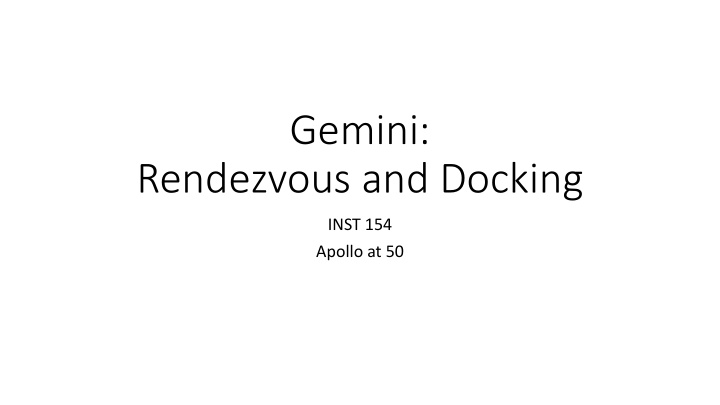



Gemini: Rendezvous and Docking INST 154 Apollo at 50
Gemini Objectives • To demonstrate endurance of humans and equipment in spaceflight for extended periods, at least eight days required for a Moon landing, to a maximum of two weeks [succeeded] • To effect rendezvous and docking with another vehicle, and to maneuver the combined spacecraft using the propulsion system of the target vehicle [succeeded] • To demonstrate Extra-Vehicular Activity (EVA), or space-"walks" outside the protection of the spacecraft, and to evaluate the astronauts' ability to perform tasks there [succeeded] • To perfect techniques of atmospheric reentry and touchdown at a pre-selected location on land [failed]
Timeline • Mercury Mark II program approval (December 1961) • Public announcement as Project Gemini (January 1962) • Last Mercury mission (May 1963) • First uncrewed Gemini mission (April 1964) • First crewed Gemini mission (March 1965) • First US Spacewalk (June 1965) • First Rendezvous (December 1965) • Uncrewed Air Force Gemini B (MOL program) launch (November 1966) • Last Gemini mission (November 1966) • Planned launch of first crewed Apollo mission (February 1967) • Air Force Manned Orbiting Laboratory program cancelled (June 1969)
Long Duration Missions (before Shuttle/Mir) • Mercury-Atlas 9 1.4 days • Gemini 4 4.1 days • Gemini 5 7.9 days • Gemini 7 13.8 days • Skylab 2 28.0 days • Skylab 3 59.5 days • Skylab 4 84.1 days
Rendezvous Missions (before Apollo 11) • Gemini 5 (Radar Evaluation Pod) [Power limitation] • Gemini 6A (first rendezvous – with Gemini 7) [Agena fail, pad abort] • Gemini 8 (first docking) [emergency reentry] • Gemini 9A (rendezvous from above) [backup crew, Atlas fail, ADTA fail] • Gemini 10 (rendezvous with an uncooperative target) • Gemini 11 (rapid one-orbit rendezvous) • Gemini 12 (unplanned rendezvous without radar) • Apollo 9 (LM-active rendezvous) • Apollo 10 (Lunar Orbit Rendezvous)
M=4 Rendezvous (e.g., Gemini 6A)
Terminal Phase
Braking Schedule Apollo LOR: Gemini 12 Pilot Report: Braking was accomplished in increments, starting with a 3 ft/sec decrease • 6000 feet: -30 fps to a closing rate of 45 ft/sec at the fourth midcourse correction. At a range of about 1.5 nautical miles, the closing rate had been decreased to • 3000 feet: -20 fps about 17 ft/sec. The inertial indicators were used for an inertial reference • 1500 feet: -10 fps during this period. The line-of-sight rates were very small throughout this portion of the braking sequence, requiring only one input correction, • 600 feet: - 5 fps according to the inertial indicators. At a range of approximately one nautical mile, inertial reference was shifted to the stars. From approximately one mile range, braking was accomplished in small increments. The analog range and range-rate indicators did not function during the braking phase. Position and closing rates were maintained by monitoring computer information and by visual observations of the target. At the completion of the rendezvous, the propellant-quantity- remaining indicator read 69 percent.
EVA Missions (before Apollo 11) • Gemini 4: Handheld maneuvering unit • Gemini 9: Backpack maneuvering unit [EVA aborted] • Gemini 10: Proximity operations • Gemini 11: Tether operations [EVA aborted] • Gemini 12: Body restraint tests • Apollo 9: No umbilical
Discussion Groups • FETM video episode 1 (“Can We Do This?”) • NASA from the lunar landing decision through the end of Project Gemini • Mathews (“Collective Knowledge Gained from Gemini”) • An conference paper providing an overview of goals and accomplishments • Summary Conference chapter 2 (“Summary of Rendezvous Operations”) • A detailed review of Gemini rendezvous • Hacker chapter 12 (“Spirit of 76”) • The story of the first rendezvous
Recommend
More recommend